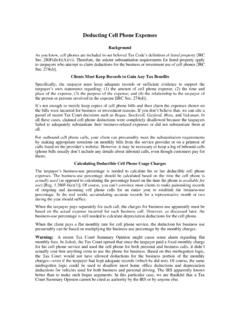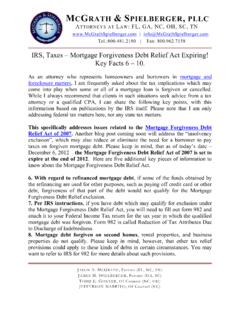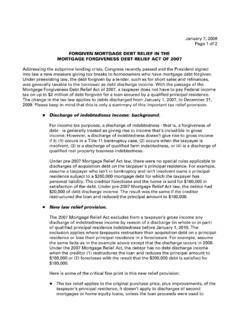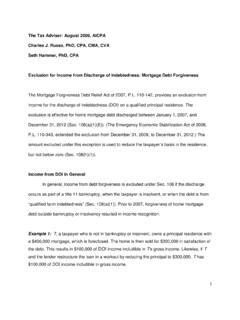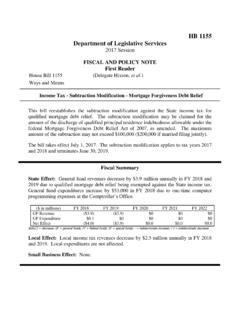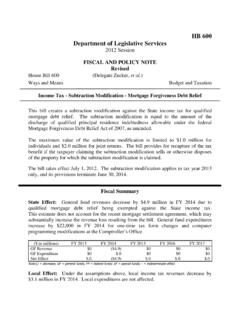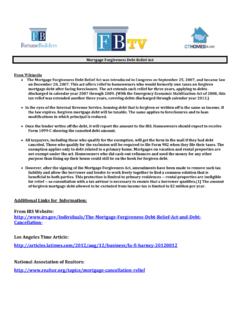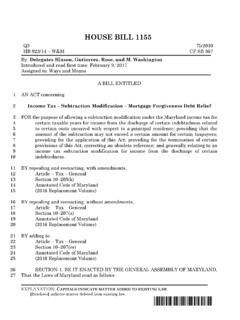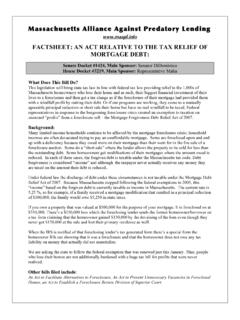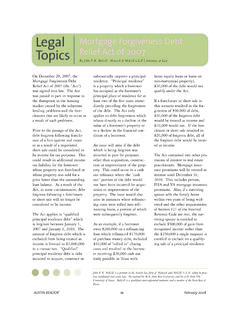Transcription of Reporting Tax-free Debt Discharge Income from a Forgiven ...
1 Reporting Tax-free debt Discharge Income from a Forgiven Home mortgage (Short-Sales) Background The bubble has burst in many residential real estate markets. Folks who bought while the bubble was still inflating may have made 2007 sales that fell into the short sale category (sale price of less than the outstanding mortgage debt against the property), or they may even have had their homes foreclosed last year. In either case, debt Discharge Income (DDI) results when a mortgage lender forgives some or all of a loan balance. Thankfully, a favorable provision included in the mortgage forgiveness debt relief Act of 2007 (the mortgage relief Act ) may save the day for many individuals. New Exception for DDI from Principal Residence Mortgages In general, DDI must be included as gross Income on the borrower s return.
2 In other words, it s taxable unless an exception applies. [See IRC Sec. 61(a)(12).] The mortgage relief Act created a new exception for certain discharges of home mortgage debt that occurs in calendar years 2007 2009. The new exception allows an eligible homeowner to exclude from gross Income up to $2 million of DDI from qualified principal residence indebtedness. [See IRC Sec. 108(a)(1)(E).] Qualified principal residence indebtedness means debt that meets the definition of acquisition indebtedness under IRC Sec. 163(h)(3)(B) on the taxpayer s principal residence but with a $2 million debt limit (or a $1 million limit for a married individual who files separately). [See IRC Sec. 108(h)(2).] Acquisition indebtedness of a principal residence means debt that is incurred in the acquisition, construction, or substantial improvement of an individual s principal residence and that is secured by that residence.
3 It includes refinanced debt to the extent the refinanced amount doesn t exceed the amount of refinanced acquisition indebtedness. (See the Joint Committee on Taxation s explanation of the mortgage relief Act.) The definition of a principal residence is the same as under the Section 121 home sale gain exclusion rules. The basis of the taxpayer s principal residence is reduced (but not below zero) by the amount that is excluded under this exception. [See IRC Sec. 108(h)(1).] Observation: As you can see, the new exception only applies with respect to debt that is used to acquire, construct, or improve the taxpayer s principal residence. Therefore, it won t help with DDI from home equity loans that were used for other purposes nor will it help with DDI from vacation home mortgages.
4 It will only help those who borrowed too much to acquire, build, or improve a principal residence. (See the examples later in this release.) If there is DDI from a loan where only part of that loan is qualified principal residence indebtedness, the exception only applies to the amount of discharged debt that exceeds the part of the loan (as determined immediately before the Discharge ) that is not qualified principal residence indebtedness. [See IRC Sec. 108(h)(4).] The exception doesn t apply to DDI if the Discharge is on account of services performed for the lender or any other factor not directly related to a decline in the value of the residence or to the taxpayer s financial condition. The exception also doesn t apply to a taxpayer in a Title 11 bankruptcy case.
5 An insolvent taxpayer (other than someone who is in a Title 11 bankruptcy case) can elect to have the new DDI exception not apply and instead rely on the more-general IRC Sec. 108(a)(1)(B) exception for insolvent taxpayers, which is briefly explained below. [See IRC Sec. 108(a)(2).] Reporting DDI Excluded under the New Exception The fact that 2007 DDI has been excluded under the new exception should be indicated by checking the box on line 1e of Part I of the updated version of form 982 (Reduction of Tax Attributes Due to Discharge of Indebtedness). The updated version is dated February 2008. Next, the amount of DDI that is excluded under the new provision should be reported on line 2 of Part I of form 982. Finally, the excluded DDI amount should be used to reduce the basis of the taxpayer s principal residence (but not below zero).
6 This basis reduction amount is reported on line 10b of Part II of form 982. If the excluded DDI amount exceeds the basis of the taxpayer s principal residence, no further attribute reduction is required. This is a favorable rule because with other types of excluded DDI, multiple tax attributes (NOLs, capital loss carryovers, passive activity loss and credit carryovers, and so forth) may have to be reduced. Example 1: DDI Can Be Excluded under New Exception. Lois and Clark, a married joint-filing couple, overpaid big time for their principal residence when local property values were skyrocketing. In 2007, the market went to heck, Clark lost his job, and the home was foreclosed. The property was burdened by a $450,000 recourse first mortgage , all of which qualified as acquisition indebtedness.
7 The first $350,000 of the mortgage was paid off when the bank sold the property in a distress sale. Lois and Clark came up with $30,000 to extinguish part of the remaining balance, and the lender forgave the last $70,000 in December of 2007. Fortunately, Lois and Clark can exclude the $70,000 of DDI from their gross Income under the new exception. To evidence this fact, form 982 should be filed with their 2007 form 1040. On form 982, the box on line 1e should be checked, the $70,000 excluded DDI amount should be reported on line 2, and $70,000 of basis reduction should be reported on line 10b. Let s say the basis of the home before the foreclosure was $525,000. After subtracting $70,000, basis was reduced to $455,000. Assuming the $350,000 price collected by the lender represented the home s FMV, Lois and Clark have a $105,000 nondeductible loss on sale ($350,000 sale price $455,000 basis).
8 Case closed. Old Law: Without the new principal residence indebtedness exception (and if none of the exceptions discussed later applied), the taxpayers would have had to recognize $70,000 of DDI and their nondeductible personal loss would have been $175,000 ($350,000 $525,000). Note: In theory, the $70,000 worth of DDI should have been reported to Lois and Clark on a 2007 form 1099-C (Cancellation of debt ) issued by the lender. But, the Reporting doesn t always happen in the right year, and sometimes it doesn t happen at all. Example 2: DDI Cannot Be Excluded under New Exception. Fritz and Stella, a married joint-filing couple, massively overindulged in borrowing against their principal residence when local property values were rising. In 2007, the chickens came home to roost, and the home had to be sold for what it could fetch, which was only $370,000.
9 It was burdened by a $275,000 recourse first mortgage (all of which was acquisition indebtedness) and a $225,000 recourse second mortgage (none of which was acquisition indebtedness) for total mortgage debt of $500,000. The property s tax basis was $280,000. The $250,000 first mortgage balance and $120,000 of the second mortgage balance were paid off when the property was sold. Fritz and Stella came up with $30,000 to extinguish part of the remaining second mortgage , and the lender forgave the last $75,000 in December of 2007. The short sale triggered a $90,000 gain ($370,000 sale price $280,000 basis). That gain can be excluded under the Section 121 home sale gain exclusion break, assuming Fritz and Stella meet the qualification rules (which they probably do). The second mortgage lender s forgiveness triggered $75,000 of DDI.
10 Because none of the Forgiven amount was acquisition indebtedness, none of the DDI can be excluded under the new exception. Instead, the entire $75,000 must be reported as gross Income on Fritz and Stella s 2007 form 1040 unless another Section 108 exception applies. Note: The $75,000 worth of DDI should have been reported to Fritz and Stella on a 2007 form 1099-C (Cancellation of debt ) issued by the second mortgage lender. Other DDI Exceptions May Apply If New Principal Residence Exception Is Unavailable. Thankfully, Section 108 of our beloved Internal Revenue Code provides a number of other exceptions to the general rule that DDI must be included in the borrower s gross Income . If one of these other exceptions applies, all or part of the taxpayer s real property mortgage DDI can be excluded from gross Income .
